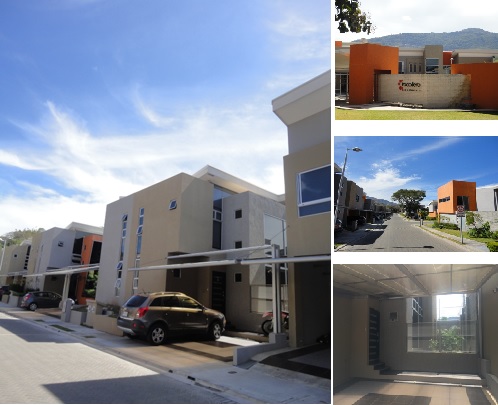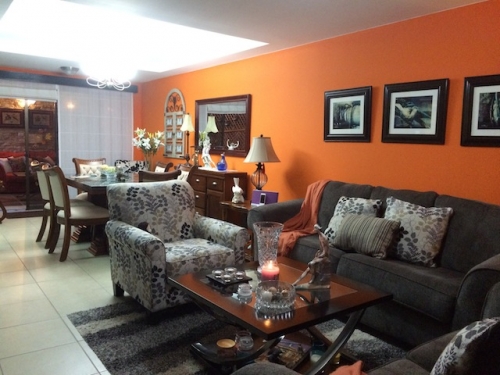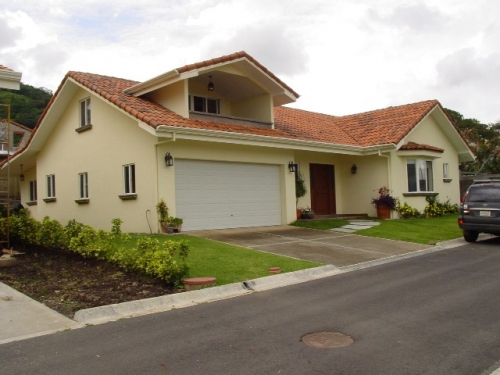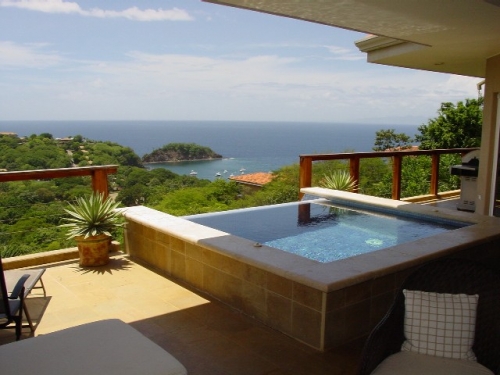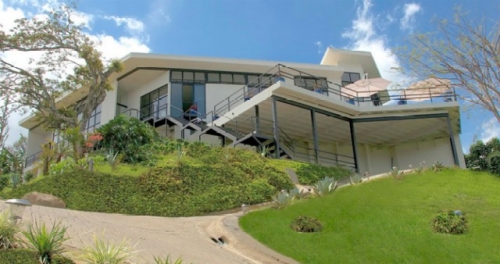Costa Rica Guide
Costa Rica Real Estate
List your property today!
Inclusion of real estate listings at Costa Rica Guide is
absolutely free of charge.
Featured Properties
Costa Rica Guide - Costa Rica Real Estate
Spotlight on Costa Rica
With an incredible array of diverse scenery and exotic wildlife, Costa Rica wows visitors with volcanoes, rainforests, uncrowded beaches and opportunities for kayaking, birding, hiking, diving and more.
By David Appell
ShermansTravel
October 2005
Adventure and eco-tourism vacations have become the hottest and fastest-growing categories of the travel industry and it's in this type of outdoorsy, back-to-nature tourism that Costa Rica has made itself a world superstar. Costa Rica adroitly leverages the many extraordinary natural and cultural wealth it packs into its little corner of Central America, a swath of territory between Nicaragua and Panama that's roughly only as big as Massachusetts and New Jersey combined, with a population of just four million. Though still a developing country economically, especially when it comes to the great outdoors, the moniker Christopher Columbus gave it, "Rich Coast," more than applies today.
Said riches include four active but not dangerous volcanoes; an abundance of fecund rain forests (including cloud forests so high up they're actually wreathed in clouds); thermal hot springs; more than 750 miles of fetching and often uncrowded beaches, especially along the Pacific coast; the Amazon-like Tortuguero preserve complete with jungle lodges; abundant wildlife from monkeys and sea tortoises to at least 850 species of birds; and plenty of adventure outfitters ready to take you birding, whitewater rafting, hiking, biking, horseback riding, fishing, scuba diving, rock-climbing, sky diving and lots more.
Indeed, one problem with Costa Rica is its sometimes bewildering range of options. With a limited amount of time to spend in the country, should you pick Arenal or Monteverde Cloud Forest for an inland foray? On the coast, should you head to Guanacaste or Manuel Antonio? We can recommend some choices. If you have little more than a long weekend to play with, you can get a good overview by spending a night in the capital, San José, then heading out to Manuel Antonio, the country's original beach resort destination; with its blend of adventure, nature, and sand/surf, we prefer this resort over Guanacaste, because it's more scenic, the resorts more intimate, and there's a national park right there.
If you have a week, we'd advise adding a trip to Arenal, a region several hours' drive north of the capital; we recommend this for its spectacular volcano, the diversity of things to do, and its relative ease of accessibility (compared to, say Monteverde, which though also marvelous is a bumpy 21-mile drive from the nearest main road, along vertiginous mountain roads at nearly 5,000 feet).
San José
Known to many locals as "Chepe," Costa Rica's capital, though attractively ringed by mountains, is itself admittedly no great looker. It does sport some nicer upscale neighborhoods, (one of which, Santa Ana, is so American-infested it's dubbed "gringo gulch"), but as with most big Central American cities, too much of it is somewhat polluted, traffic-clogged and, frankly, dumpy. But, since you'll likely fly in here anyway, it does have some charms worth spending a day or two discovering: a handful of museums including an interesting one showcasing pre-Columbian gold; some good restaurants; and a few fine hotels, among them several that were converted from century-old manses that once belonged to families made wealthy by coffee (still a big local industry).
Locals complain about the crime here, but it rarely goes beyond pick-pocketing; take the same precautions you'd take in any big city, and you'll be just fine. The tourist office has a branch at the airport and another downtown next to the gold museum (Plaza de la Cultura; 506/222-1090); both are open weekdays 9am-5pm. You can walk most everywhere you need to go, saving taxis for the occasional restaurant, museum, and—depending on where you end up staying—your hotel. If you want a city tour for orientation, however, Gray Line runs a half-day San José City Explorer tour that takes in most of our favored sights, including admission (noon; $42; www.graylinecostarica.com). Of the local attractions, the following are the ones you should try not to miss.
Exploring San José
Possibly the prettiest historic building in Central America may be the Teatro Nacional (Avenida 2 at Calle 5; Mon - Sat 9am-4pm; guided tours six times daily; $3; www.teatronacional.go.cr), built by the city's rich coffee planters at the end of the 19th century to imitate legends like La Scala and the Opéra in Paris. You can cop a free peek at all the marble, gilt, and red velvet even if you don't catch a performance; there's also a nice and similarly grandiose café right off the lobby, where you can have a drink, sandwich or pastry.
Fans of both shiny yellow metal and ancient Mesoamerican culture will dig downtown's underground Museo del Oro Precolombino (Calle 5 at Plaza de la Cultura; daily 9.30am-5pm; $6), the museum of pre-Columbian gold. It's nicely designed, and though most of the pieces are smallish to downright itsy-bitsy, the images and workmanship are fascinating. A coin museum is attached, and included in admission, but frankly, you'd have to be a hardcore numismatist to really appreciate this one. Even more prized by Mesoamerican culture was jade, and serveral blocks northeast of the gold museum, the cool Museo de Jade (Avenida 7 at Calle 9; Mon-Fri 8.30am-4pm; $1; (http://ns.cr/arte/jade/musejade.htm) is a real treat, covering other pre-Columbian objects besides jade-work.
A bit west of downtown at the edge of Parque La Sabana Este, the (Calle 42 at Paseo Colon; Tue.-Sun. 10am-4pm; 75¢; ns.cr/arte/musearte/musearte.htm) now comes across more like a Spanish colonial manse complex than the airport terminal it once was. It's worth a stop for its nice collection of local fine art from the 19th century up to the present. History and archeology buffs might also consider heading a few blocks east of downtown to the Museo Nacional (Calle 17 at Plaza de la Democracia; Tue-Sat 8.30am-4.30pm, Sun 9am-4.30pm; $4; www.museocostarica.go.cr), set in a 19th-century fortress where the army used to have its HQ before being abolished in 1948; there's some wonderful pre-Columbian art and artifacts, as well as exhibits and art covering the colonial period to the present day.
Finally, a short way outside San José, in the nearby town of Heredia, java junkies will get a kick out of a visit to Café Britt (Dec 15 - April 9am, 11am & 3pm; May - Dec 14 11am only; $19 - $39; www.coffeetour.com), which involves a tour, show, tastings and lunch at a coffee plantation run by the country's best-known brand-name (they'll pick you up at your hotel if you don't have your own wheels); admittedly a bit touristy, it's also entertaining, and you might find it a hoot as well as educational.
Manuel Antonio
About three-and-a-half hours by road (30 minutes by air) from San José, Costa Rica's first major beach destination is still, in our opinion, its most fetching. First and foremost, its setting is the most scenic: many of its resorts are nestled in the lush hills that slope down to Playa Espadilla, the main beach, and Parque Nacional Manuel Antonio (from whence the area's name), with gorgeous views out over jungle and sea. And, unlike more recently developed areas up the Pacific coast, Manuel Antonio's atmosphere, and its resorts, are more intimate and have a feel quite different from, say, the spring-break-style vibe of Jacó, the edgy seediness of Puntarenas, or the increasingly large mass-market all-inclusives and other big resorts increasingly common in Papagayo, Tamarindo, and other beach destinations farther north in arid but booming, and increasingly popular, Guanacaste.
Exploring Manuel Antonio
Essentially set up around a large hill flanked by two headlands that jut out into the Pacific, Manuel Antonio's resorts are strung along two roads, one of which leads out to the end of Punta Quepos while the other descends the hill to the water's edge and the national park entrance, on Punta Catedral. Along the portion of beachfront road that runs along the bay to the park is the closest thing you'll find to a town in Manuel Antonio proper: a kind of hamlet consisting of two to three blocks of restaurants, shops, souvenir stands, and some lodgings. The primary swimming beaches (playas) begin along this waterfront boulevard and continue inside the park, which has the most appealing stretches of sand of all. Since there is a bit of distance to cover between many of the resorts and the beaches (not to mention the town of Quepos, a longer drive away), having your own wheels can be helpful but it's not essential, since you can use taxis, resort shuttles, and public transportation to get around.
It's not all about the beach here, though you could easily make it so. The Parque Nacional Manuel Antonio (daily 8am-4pm; $10 advance or $15 at entrance; www.costarica-nationalparks.com) is ready made for ecotourist adventures from hiking, horseback riding, rafting, ATV driving, hang gliding and zipline canopy tours. The 4014-acre park ranks as one of Costa Rica's most often visited; it offers a small network of trails that might take you a couple of hours to hike while watching for squirrel or white-faced capuchin monkeys, sloths, iguanas, green kingfishers and other wildlife along the way. Once you're ready for some refreshment—meaning only immersion in water, since no food or drink is sold inside the park—head to one of the various small crescent beaches like Playa Espadilla Sur, Playa Manuel Antonio (considered the nicest for swimming), Playa Puerto Escondido, and Playa Playitas (the farthest from the entrance, and especially popular with the gay crowd). Plenty of local outfitters can help you take advantage of what the park and this part of the coast has to offer; our best picks include Fourtrax and Sea Adventures (www.fourtraxadventure.com); H2O Adventures (www.aventurash2o.com); Titi Canopy Tour (www.titicanopytours.com); Hang Glide Costa Rica (www.hangglidecostarica.com); and Finca Valmy Tours (for horseback riding; http://valmytours.com).
Arenal
A three- to four-hour drive on decent roads from San José (four- to four-and-a-half hours from Manuel Antonio), this area of rolling hills and forests in the center of Costa Rica's northern zone has become a top draw for a good reason—except for beaches, it offers an excellent cross section of the country's charms. You've got the usual panoply of activities (rafting, horseback riding, mountain biking, caving, canopy tours and trams) plus windsurfing and boating on pretty, manmade Lake Arenal; you can even visit an Indian reserve. But the centerpiece, and raison d'être for the area's popularity, is majestic, looming Arenal volcano, one of the world's most active erupters (but considered safe since its last major eruption in 1968). It puts on spectacular shows (most nights) of frothy glowing lava (your best chances of catching the big guy's awesome eruptions are better January through March) and, as an added benefit, there are a number of volcanically-warmed natural springs in the area that have been harnessed, landscaped and turned into "mini-resorts" such as Tabacón, Las Fuentes and Baldi. The nearest town, 10 miles downhill from the volcano, is La Fortuna; it's not what you'd call the most picturesque place around but is pleasant enough and makes a good base of operations.
Exploring Arenal
To take full advantage of what this region has to offer, you'll want to check with some of the various local outfitters, including Aventuras Arenal (www.arenaladventures.com); Sunset Tours (www.sunsettourcr.com); Eagle Tours (www.eagletours.net), Fourtrax Adventures ATV tours (www.fourtraxadventure.com); Original Canopy Tour (www.canopytour.com); and Desafío Adventure Tours (www.desafiocostarica.com) for rafting and kayaking.
The 30,000-acre reserve that is Parque Nacional Volcán Arenal (daily 8am-10pm; $6; www.costarica-nationalparks.com) is centered around the eponymous 5436-foot-high volcano, the manmade lake below it, and a neighboring volcanic cone called El Chato. You can hike a series of trails through forests and old lava flows, from some of which you can actually see newly flowing lava—just don't get too close to the slopes of the volcano itself. The well-marked hiking trails range from a half-mile to two-and-a-half miles in length, and pass past phantasmagoric vistas and dreary low-lying areas that might remind Lord of the Rings fans of the dead flatlands of Mordor. Several also go down to or along Lake Arenal; one even goes to a waterfall. Most are not very strenuous; the one exception might be the "Lava Trail" which can be a tough climb, but you'll be rewarded with stunning vistas of flowing lava from a perched observation deck. Flora includes exotic heliconias, orchids, bromeliads and lots of ferns; fauna-wise, expect to see brilliant blue morpho butterfies, toucans and other birds, howler monkeys and agoutis (large, tailless rodents).
For viewing the eruptions at night, you'll have to come back with one of the tour companies (see above), as the park is otherwise closed to visitors after dark. Try not to be too disappointed if the weather happens to be cloudy when you're here and the summit is therefore shrouded—the volcano is an inspiring sight, no matter what. There's a visitor center with café and restrooms on site as well.
On the way up the road to the volcano from La Fortuna, you'll pass several balnearios, mini-resorts built around geothermal springs warmed by Arenal's vulcanism. The best-known and most impressive is Tabacón (daily noon-10pm; $29; www.tabacon.com), an elaborately landscaped series of hot streams, pools, and waterfalls, some mimicking natural formations, others resort-style (the biggest one boasts a swim-up bar and water slide); there's also a spa and restaurant on premises. A few steps down the road, under the same ownership, Las Fuentes (daily 10am-10pm; $8 - $10) is less intricate but still a lot of fun, and since it's less expensive, it's also more popular with locals. Downhill, just a couple of miles out of town, Baldi Hot Springs (daily 10am-10pm; $17; www.infoturistica.com) is less naturalistic than the above, with pools that feel more like those at a big tourist resort (complete, in some cases, with party music). A good antidote is the nearby family-owned Eco Termales (daily 10am-9pm; 506/479-8484; $15), also nicely landscaped but with a more laid-back, intimate feel; it's open by reservation only.
Where to eat and drink
San José: A wide variety of dining choices, from humble sodas (cheap but often good rice-and-beans joints) to truly fine cuisine we'd stack up against nearly any in New York or London, are scattered all over the city. On the upper end, our favorite is La Luz (Carretera Vieja Santa Ana; 506/282-4160), in the Alta Hotel (see above), serving stylish nouvelle Latin and international fare, and the charming restaurant at El Grano de Oro (Calle 30/Avenidas 2 & 4; 506/255-3322) comes a close second. Slightly less expensive, yet atmospheric, tasty, and more centrally located, Café Mundo (Calle 15 at Avenida 9; 506/222-6190), attracts an artsy and young crowd with varied multi-culti morsels dished up in an old colonial wooden house.
For affordability and local color, check out the Costa Rican home cooking at Nuestra Tierra (Avenida 2/Calle 15; 506/258-6500) and the newish Típica (Avenida 2/Calle 10; 226-5296), open-air eateries mimicking rough-hewn country houses. For people-watching and views of the historic National Theater, try the light local fare served on the portico of downtown's classic Gran Hotel Costa Rica (Plaza Mora Fernández; 506/221-4000). Or catch the 1001 Arabian Nights vibe at Barrio Amón's recently opened Café Moro (Calle 3/Avenida 11 & 13; 506/223-3116), with Latin and Middle Eastern fare in the courtyard of an old neo-Moorish townhouse.
Manuel Antonio: The top tables in this neck of the woods are those at the better resorts (see above) but several stand-alone spots do merit mention as well. Along the beachfront road, we like the atmosphere and Latin/international/Tex-Mex food at Marlin Restaurante (506/777-1134); just down the street, the local chow is also good and the prices even better at Mar y Sombra (506/777-0510), in an idyllic tree-shaded setting right on the sand (at night it turns into a popular disco). Up the hill, the happy hour with boffo sunset views and hopping nighttime scene at Barba Roja (506/777-0331) are popular with gringos. Finally, Quepos is the place for sturdy budget repasts, and you'll have no trouble getting well fed for a pittance in plenty of sodas throughout town. We'd be remiss, though, if we didn't mention a local institution called El Gran Escape (506/777-0395), another gringo-flavored spot on the waterfront featuring great fresh seafood.
Arenal: As in other resort towns, the best and priciest restaurants hereabouts are at the uphill resorts (see above), especially Los Tucanes (506/519-1900) at Tabacón and Acuarelas (460-1220) at Montaña de Fuego, both of which do a delicious job of fusing local ingredients and elements with sophisticated international flair. In La Fortuna, much of the dining tends toward the local and inexpensive. Good choices include La Choza de Laurel (506/479-9231), built to evoke a traditional native hut; Rancho La Cascada (506/479-9145), under a soaring palapa roof, on the park in the center of town; and Los Nenes (506/479-9192), on a side street off the main drag, more of a local than tourist joint.
Where to stay
San José: There are adequate to admirable accommodations in all price ranges in various parts of town. Your best full-service upscale bet within walking distance of the museums and downtown is the 107-room Radisson Europa (www.radisson.com), with a pool, restaurant, and casino. But if you don't mind being a little away from the center, we adore a stylish hotel called the Alta Hotel (www.thealtahotel.com), in the western suburbs of Escazú, because of its compelling updated-hacienda architecture, romantic vibe, and its superb restaurant, one of San José's best.
In the moderate range you can find some of the capital's most historic properties, mostly restored coffee barons' mansions; the most praised and pretty is El Grano de Oro (www.hotelgranodeoro.com), with 35 rooms, a very good destination restaurant, and perks such as a pair of rooftop Jacuzzis.
Entering bargain territory, we like a sprawling, quiet 35-roomer called Hotel Aranjuez (www.hotelaranjuez.com), an eco-friendy choice in the neighborhood of the same name just east of the center of town. If you want to go rock-bottom, we'd recommend the Hostel Pangea (www.hostelpangea.com), in the historic, fairly central Amón neighborhood.
Manuel Antonio: Most of the more upscale resorts are scattered across the big forested hill sloping down to the beach and national park, while midrange and budget choices can be found toward the bottom near the beach (it sounds counterintuitive, but consider that the higher up the hill, the better the views); a variety of low-cost options also exist in the neighboring town of Quepos, which requires a bus or taxi ride to Manuel Antonio. The most fetching top-end resort in our book is the Hotel Makanda by the Sea (www.makanda.com), an adults-only assortment of 11 contemporary villas and studios perched on the hillside; there's a beautiful pool and restaurant, and of course the views are to die for. Several other wonderful resorts in the same price range boast more bells and whistles but are slightly more conventional. For tropical flavor, mind you, we love Sí Como No (www.sicomono.com), and, for its old-Europe ambience, none can compare to El Parador (www.hotelparador.com). Possibly the best views of all are on offer at La Mariposa (www.hotelmariposa.com), perched at the very top of the hill; even if you don't stay here, do stop by for a cocktail.
If you're watching your wallet, a good midrange choice is the Casitas Eclipse (www.casitaseclipse.com), with a whitewashed, upscale-feeling resort atmosphere at value rates. Somewhat less pricey are the colorful Banana Tree (www.bananatreehotel.com), a hop and a skip down the hill, and the Beach Hotel Espadilla (www.espadilla.com), at sea level just a block from the sand. For the best of the budget pack, you'll have to head over to Quepos, where the recently opened Widemouth Frog (www.widemouthfrog.org) is very clean, welcoming, and well-equipped (complete with pool) for the backpacker set.
Arenal: The town of La Fortuna is the place to look for budget options; the midrange and luxe lodges and resorts are found out of town, along the road leading up to the national park and the lake (though there are a smattering of more economical digs along here, as well). The most luxurious is probably Tabacón Hot Springs Resort & Spa (www.tabacon.com), whose full panoply of amenities includes admission to the eponymous hot-springs park nearby—book well in advance. A notch down in price, another classy choice is Montaña de Fuego (www.montanadefuego.com), with a fine spa and one of the best restaurants in the area, and Los Lagos (www.hotelloslagos.com), an enormous hillside spread with bells and whistles like a spa, hot springs, slide-equipped pools and even live crocodiles.
For its lovely forest setting and truly spectacular volcano views, though, we have a soft spot for the Arenal Observatory Lodge (www.arenal-observatory.co.cr), a refurbished Smithsonian research station which now boasts most of the expected resort perks and comforts at moderate prices. If you're looking to save as much as possible without stinting on country setting and views, the Roca Negra Inn (506/479-9237; rocanegrainn@yahoo.com) is a handful of nicely equipped units just outside town.
In La Fortuna itself (a convenient base because that's where most of the restaurants, shops, and tour operators are), your best budget bet is Luigi's (www.luigishotel.com), a good motel-like set-up with pool and a nice Italian restaurant. The most recommendable rock-bottom choice (and there are some truly dismal and dreary ones) is Hotel La Fortuna (www.fortunainn.com), whose cantina serves tasty low-cost local fare, as well.
Copyright 2005
Note: The above information is not to be used for any other purpose other than private study, research, criticism or review. Thank you.

